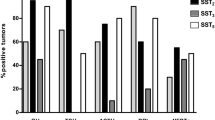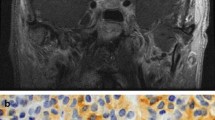Abstract
Thyrotropin-secreting pituitary adenomas (TSHomas) are a rare cause of hyperthyroidism and account for less than 2% of pituitary adenomas. Medical therapy with somatostatin analogues (SSAs) effectively reduces TSH secretion in approximately 80% of patients and induces shrinkage in about 45% of tumors. According with previous data, resistance to SSA treatment might be due to heterogeneity in somatostatin receptors (SSTRs) expression. We report the case of TSHoma in a 41-year-old man treated with octreotide LAR that caused a dramatic decrease of TSH and thyroid hormones and tumor shrinkage already after 3 months of pre-surgical therapy. In search of potential molecular determinants of octreotide effectiveness, we measured, in primary cultures from this tumor, SSTR and dopamine D2 receptor (D2R) expression, and octreotide and/or cabergoline effects on TSH secretion and cell proliferation. SSTR5 and D2R expression was higher than SSTR2. Octreotide significantly inhibited TSH secretion more effectively than cabergoline (P < 0.001), whereas the combined treatment was comparable with cabergoline alone. Similarly, octreotide resulted more effective than cabergoline on cell proliferation, while the combination did not show any additive or synergistic effects. In conclusion, the significant antisecretive and antiproliferative effect of octreotide in this patient might be related to the high expression of SSTR5, in the presence of SSTR2. After reviewing the literature, indeed, in line with previous observations, we hypothesize that SSTR5/SSTR2 ratio in TSHomas may represent a useful marker in predicting the outcome of therapy with SSAs. The role of D2R should be further explored considering that the presence of D2R can influence SSTRs functionality.



Similar content being viewed by others
References
Comi RJ, Gesundheit N, Murray L, Gorden P, Weintraub BD (1987) Response of thyrotropin-secreting pituitary adenomas to a long-acting somatostatin analogue. N Engl J Med 317:12–17
Beck-Peccoz P, Brucker-Davis F, Persani L, Smallridge RC, Weintraub BD (1996) Thyrotropin-secreting pituitary tumors. Endocr Rev 17:610–638
Ferone D, Gatto F, Arvigo M, Resmini E, Boschetti M, Teti C, Esposito D, Minuto F (2009) The clinical-molecular interface of somatostatin, dopamine and their receptors in pituitary pathophysiology. J Mol Endocrinol 42:361–370
Hofland LJ, van Koetsveld PM, Wouters N, Waaijers M, Reubi JC, Lamberts SW (1992) Dissociation of antiproliferative and antihormonal effects of the somatostatin analog octreotide on 7315b pituitary tumor cells. Endocrinology 131:571–577
Florio T, Thellung S, Corsaro A, Bocca L, Arena S, Pattarozzi A, Villa V, Massa A, Diana F, Schettini D, Barbieri F, Ravetti JL, Spaziante R, Giusti M, Schettini G (2003) Characterization of the intracellular mechanisms mediating somatostatin and lanreotide inhibition of DNA synthesis and growth hormone release from dispersed human GH-secreting pituitary adenoma cells in vitro. Clin Endocrinol (Oxf) 59:115–128
Danila DC, Haidar JN, Zhang X, Katznelson L, Culler MD, Klibanski A (2001) Somatostatin receptor-specific analogs: effects on cell proliferation and growth hormone secretion in human somatotroph tumors. J Clin Endocrinol Metab 86:2976–2981
Ren SG, Taylor J, Dong J, Yu R, Culler MD, Melmed S (2003) Functional association of somatostatin receptor subtypes 2 and 5 in inhibiting human growth hormone secretion. J Clin Endocrinol Metab 88:4239–4245
Florio T, Thellung S, Arena S, Corsaro A, Spaziante R, Gussoni G, Acuto G, Giusti M, Giordano G, Schettini G (1999) Somatostatin and its analog lanreotide inhibit the proliferation of dispersed human non-functioning pituitary adenoma cells in vitro. Eur J Endocrinol 141:396–408
Yoshihara A, Isozaki O, Hizuka N, Nozoe Y, Harada C, Ono M, Kawamata T, Kubo O, Hori T, Takano K (2007) Expression of type 5 somatostatin receptor in TSH-secreting pituitary adenomas: a possible marker for predicting long-term response to octreotide therapy. Endocr J 54:133–138
Horiguchi K, Yamada M, Umezawa R, Satoh T, Hashimoto K, Tosaka M, Yamada S, Mori M (2007) Somatostatin receptor subtypes mRNA in TSH-secreting pituitary adenomas: a case showing a dramatic reduction in tumor size during short octreotide treatment. Endocr J 54:371–378
Spada A, Bassetti M, Martino E, Giannattasio G, Beck-Peccoz P, Sartorio A, Vallar L, Baschieri L, Pinchera A, Faglia G (1985) In vitro studies on TSH secretion and adenylate cyclase activity in a human TSH-secreting pituitary adenoma. Effects of somatostatin and dopamine. J Endocrinol Invest 8:193–198
Wood DF, Johnston JM, Johnston DG (1991) Dopamine, the dopamine D2 receptor and pituitary tumours. Clin Endocrinol (Oxf) 35:455–466
Neto LV, Machado Ede O, Luque RM, Taboada GF, Marcondes JB, Chimelli LM, Quintella LP, Niemeyer P Jr, de Carvalho DP, Kineman RD, Gadelha MR (2009) Expression analysis of dopamine receptor subtypes in normal human pituitaries, nonfunctioning pituitary adenomas and somatotropinomas, and the association between dopamine and somatostatin receptors with clinical response to octreotide-LAR in acromegaly. J Clin Endocrinol Metab 94:1931–1937
Rocheville M, Lange DC, Kumar U, Patel SC, Patel RC, Patel YC (2000) Receptors for dopamine and somatostatin: formation of hetero-oligomers with enhanced functional activity. Science 288:154–157
Grant M, Alturaihi H, Jaquet P, Collier B, Kumar U (2008) Cell growth inhibition and functioning of human somatostatin receptor type 2 are modulated by receptor heterodimerization. Mol Endocrinol 22:2278–2292
Barbieri F, Bajetto A, Stumm R, Pattarozzi A, Porcile C, Zona G, Dorcaratto A, Ravetti JL, Minuto F, Spaziante R, Schettini G, Ferone D, Florio T (2008) Overexpression of stromal cell-derived factor 1 and its receptor CXCR4 induces autocrine/paracrine cell proliferation in human pituitary adenomas. Clin Cancer Res 14:5022–5032
Florio T, Barbieri F, Spaziante R, Zona G, Hofland LJ, van Koetsveld PM, Feelders RA, Stalla GK, Theodoropoulou M, Culler MD, Dong J, Taylor JE, Moreau JP, Saveanu A, Gunz G, Dufour H, Jaquet P (2008) Efficacy of a dopamine-somatostatin chimeric molecule, BIM-23A760, in the control of cell growth from primary cultures of human non-functioning pituitary adenomas: a multi-center study. Endocr Relat Cancer 15:583–596
Florio T, Pan MG, Newman B, Hershberger RE, Civelli O, Stork PJ (1992) Dopaminergic inhibition of DNA synthesis in pituitary tumor cells is associated with phosphotyrosine phosphatase activity. J Biol Chem 267:24169–24172
Chanson P, Weintraub BD, Harris AG (1993) Octreotide therapy for thyroid-stimulating hormone-secreting pituitary adenomas. A follow-up of 52 patients. Ann Intern Med 119:236–240
Ohki M, Sato K, Tuchiya D, Sato S, Saito S, Kinjo T, Kayama T, Jokura H, Yoshimoto T (1999) A case of TSH-secreting pituitary adenoma associated with an unruptured aneurysm: successful treatment by two-stage operation and gamma knife. No To Shinkei 51:895–899
Macchia E, Gasperi M, Lombardi M, Morselli L, Pinchera A, Acerbi G, Rossi G, Martino E (2009) Clinical aspects and therapeutic outcome in thyrotropin-secreting pituitary adenomas: a single center experience. J Endocrinol Invest 32:773–779
Socin HV, Chanson P, Delemer B, Tabarin A, Rohmer V, Mockel J, Stevenaert A, Beckers A (2003) The changing spectrum of TSH-secreting pituitary adenomas: diagnosis and management in 43 patients. Eur J Endocrinol 148:433–442
Mannavola D, Persani L, Vannucchi G, Zanardelli M, Fugazzola L, Verga U, Facchetti M, Beck-Peccoz P (2005) Different responses to chronic somatostatin analogues in patients with central hyperthyroidism. Clin Endocrinol (Oxf) 62:176–181
Sharif N, Gendron L, Wowchuk J, Sarret P, Mazella J, Beaudet A, Stroh T (2007) Coexpression of somatostatin receptor subtype 5 affects internalization and trafficking of somatostatin receptor subtype 2. Endocrinology 148:2095–2105
Filopanti M, Ballare E, Lania AG, Bondioni S, Verga U, Locatelli M, Zavanone LM, Losa M, Gelmini S, Peri A, Orlando C, Beck-Peccoz P, Spada A (2004) Loss of heterozygosity at the SS receptor type 5 locus in human GH- and TSH-secreting pituitary adenomas. J Endocrinol Invest 27:937–942
Werner S (1979) Human pituitary adenomas with hypersecretion of TSH and prolactin. Evidence that receptor sites for dopamin may be absent on TSH producing while present on prolactin producing cells. Horm Metab Res 11:452–453
Bevan JS, Burke CW, Esiri MM, Adams CB, Ballabio M, Nissim M, Faglia G (1989) Studies of two thyrotrophin-secreting pituitary adenomas: evidence for dopamine receptor deficiency. Clin Endocrinol (Oxf) 31:59–70
Shimatsu A, Murabe H, Nakamura Y, Mizuta H, Ihara C, Nakao K (1999) Long-term treatment with bromocriptine of a plurihormonal pituitary adenoma secreting thyrotropin, growth hormone and prolactin. Endocr J 46:159–165
Wollesen F, Andersen T, Karle A (1982) Size reduction of extrasellar pituitary tumors during bromocriptine treatment. Ann Intern Med 96:281–286
Faglia G, Beck-Peccoz P, Piscitelli G, Medri G (1987) Inappropriate secretion of thyrotropin by the pituitary. Horm Res 26:79–99
Scanlon MF, Howells S, Peters JR, Williams ED, Richards S, Hall R, Thomas JP (1985) Hyperprolactinaemia, amenorrhoea and galactorrhoea due to a pituitary thyrotroph adenoma. Clin Endocrinol (Oxf) 23:35–42
Kienitz T, Quinkler M, Strasburger CJ, Ventz M (2007) Long-term management in five cases of TSH-secreting pituitary adenomas: a single center study and review of the literature. Eur J Endocrinol 157:39–46
Colao A, Filippella M, Pivonello R, Di Somma C, Faggiano A, Lombardi G (2007) Combined therapy of somatostatin analogues and dopamine agonists in the treatment of pituitary tumours. Eur J Endocrinol 156(Suppl 1):S57–S63
Baragli A, Alturaihi H, Watt HL, Abdallah A, Kumar U (2007) Heterooligomerization of human dopamine receptor 2 and somatostatin receptor 2 Co-immunoprecipitation and fluorescence resonance energy transfer analysis. Cell Signal 19:2304–2316
Zatelli MC, Piccin D, Tagliati F, Bottoni A, Ambrosio MR, Margutti A, Scanarini M, Bondanelli M, Culler MD, degli Uberti EC (2005) Dopamine receptor subtype 2 and somatostatin receptor subtype 5 expression influences somatostatin analogs effects on human somatotroph pituitary adenomas in vitro. J Mol Endocrinol 35:333–341
Ferone D, de Herder WW, Pivonello R, Kros JM, van Koetsveld PM, de Jong T, Minuto F, Colao A, Lamberts SW, Hofland LJ (2008) Correlation of in vitro and in vivo somatotropic adenoma responsiveness to somatostatin analogs and dopamine agonists with immunohistochemical evaluation of somatostatin and dopamine receptors and electron microscopy. J Clin Endocrinol Metab 93:1412–1417
Ferone D, Saveanu A, Culler MD, Arvigo M, Rebora A, Gatto F, Minuto F, Jaquet P (2007) Novel chimeric somatostatin analogs: facts and perspectives. Eur J Endocrinol 156(Suppl 1):S23–S28
Saveanu A, Jaquet P (2009) Somatostatin-dopamine ligands in the treatment of pituitary adenomas. Rev Endocr Metab Disord 10:83–90
Acknowledgments
We sincerely acknowledge Anne-Laure Germanetti for performing the quantitative RT-PCR analysis. This study was partially supported by grant from Italian Minister of Instruction, University and Research (PRIN 2008 n. 2008LFK7J5_004).
Conflict of interest
The Authors report no conflict of interest in the present manuscript.
Author information
Authors and Affiliations
Corresponding author
Additional information
Federico Gatto and Federica Barbieri equally contributed to the paper.
Rights and permissions
About this article
Cite this article
Gatto, F., Barbieri, F., Castelletti, L. et al. In vivo and in vitro response to octreotide LAR in a TSH-secreting adenoma: characterization of somatostatin receptor expression and role of subtype 5. Pituitary 14, 141–147 (2011). https://doi.org/10.1007/s11102-010-0271-2
Published:
Issue Date:
DOI: https://doi.org/10.1007/s11102-010-0271-2




